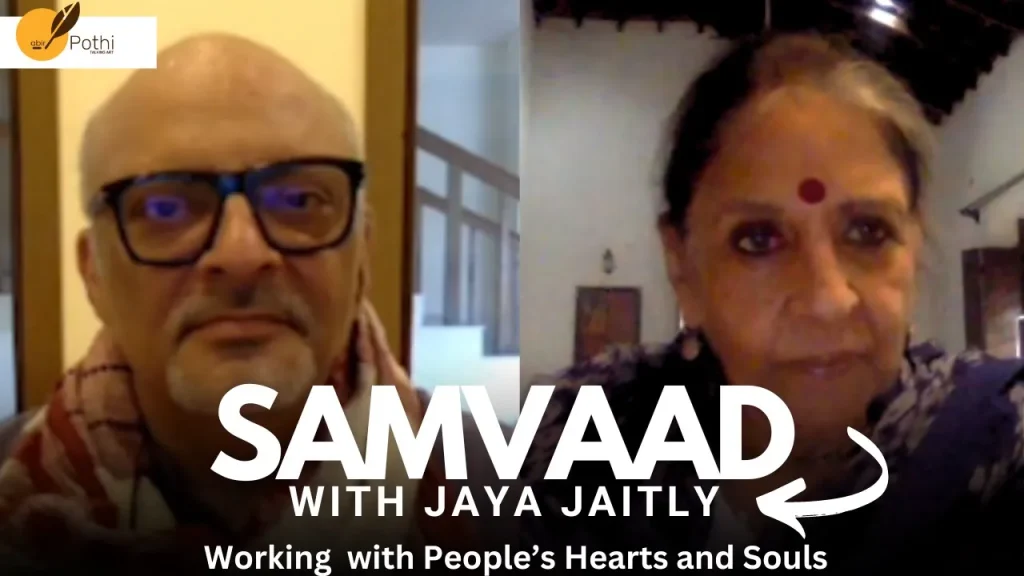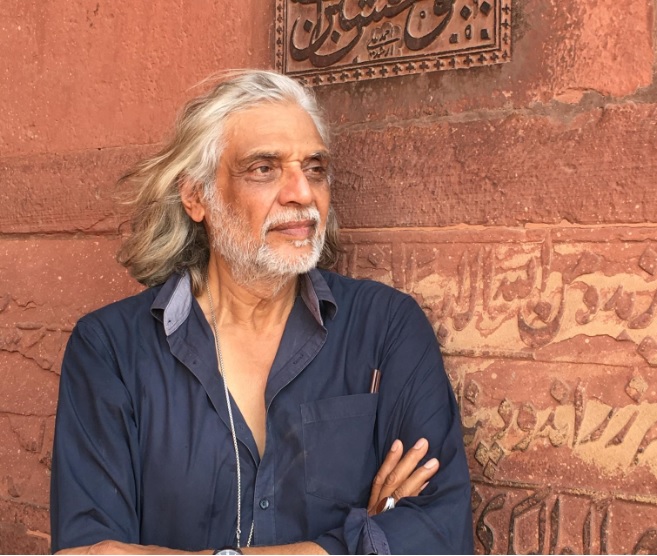Welcome to Samvaad, where art meets conversation, and inspiration knows no bounds. Here we engage in insightful conversations with eminent personalities from the art fraternity. Through Samvaad, Abir Pothi aims to create a platform for thought-provoking discussions, providing readers with an exclusive glimpse into the creative processes, inspirations, and experiences of these creative individuals. From curating groundbreaking exhibitions to pushing the boundaries of artistic expression, our interviews shed light on the diverse perspectives and contributions of these art luminaries. Samvaad is your ticket to connect with the visionaries who breathe life into the art world, offering unique insights and behind-the-scenes glimpses into their fascinating journeys.
This is Part 5 of the Samvaad is between Nidheesh Tyagi from Abir and Jaya Jaitly who is best known for her contributions to the promotion and preservation of Indian handicrafts and textiles. Jaitly has played a significant role in the development of the Indian handicraft sector and has been an advocate for the rights and welfare of artisans. She has been actively involved in various organisations working towards the empowerment of artisans and the promotion of traditional crafts. Jaya Jaitly has also written extensively on Indian crafts, culture, and social issues.
Nidheesh: So this “haat” itself is a very interesting way to bring a very rural concept to a very urban setting. I’ve been to Dilli-haat several times it’s so different from the usual bazaars in Delhi or any urban cities these days. So tell me more about it, when you talk to the architects for Goa or elsewhere, how do you go about a local, modern haat?
Jaya: Well Dilli-haat was something where, again, I believed that the stars aligned. Because this was just about the time when globalisation had come in and this word “market market market” was everywhere. But because of my political backgorund we were saying that, “ why is the market opening up for coca-cola and potato chips and why are there malls and supermarkets coming up when we have our very nice sabzi-waalas around the corner. Why are we killing the humanness of what we have in India?”
Plus I had been visiting over the years many local haats. Especially bihar has so many. Bengal has handloom Haats. And I find that form of marketing very beautiful. It’s a very socialising place. The haat in bustar, you have alcohol, cockfights, mitti ka khilauna, (toys made of clay) kapda (clothes), sabzi (vegetables), chutney, all lovely culture comes up in a haat and after that they brew their mauwa and they drink and they go dancing all the way home. That to me is the most wonderful expression of marketing which was a social place- socialising, enjoying, entertainment, gossiping, bargaining, everything.
So I had, gotten to my system, so when this globalisation in malls had started. I said “we must also open a market spaces in cities for our rural people. Why should they always be at the hands of middlemen , 3 levels of expression and exploitation happens before they get their money.” So I thought that, “why don’t we make a haat”. I asked the various departments of the Delhi government and they said “give us the forecast of how in the next 5 years how much you will sell” I said I have no idea. I can’t do all that. It’s an idea and we should try it because it works in the village, why can’t it work here? And the exact system of the village. Two weeks each, because if you do more than that you are a dukaandaar you are not a karigar. Let the karigar come and meet the customer, designer, students, old men, and let him do all that, why do you have in-betweens to say “yeh nahi bikega-voh nahi bikega” (this won’t sell-that won’t sell).
So to think, it was a design input learning to collaborate with each other on a common platform so my Socialism again came to the fore. Anyone making things with their hands, man, woman, caste, creed, religion, sit in line together. Your common interest is to sell well. And help each other out. So all of these thoughts came in and I kind of made up a plan, and nothing much happened till there was all that trouble in Kashmir. When the terrorism started in the early 90s with V.P. Singh etc. so I said- the craftspeople were really crying but tourists are coming to Kashmir (at the time) 7 lakh tourists stopped coming and the government was thinking of spending crores on setting up Kashmiri bazaars to help those craftspeople.
Nidheesh: Yeah they have one around INA. I’ve seen it around there.
Jaya: Yes it’s all rubbish. Just being used by others in Kashmiri names.
Nidheesh: Yes.
Jaya: So then I said that “why can’t we make a space which is for craftspeople who are affected by terrorism today, militancy tomorrow, floods and drought somewhere? And even expert rejects where people make something by hand and “ek dhaaga rang theek nahi tha toh wapas karr do” (one thread-work was not perfect so return it all) so these people also need to have a place for offtake. And let them learn it cost, also because at that time they were saying that nothing will be subsidized and stuff will be cut down. So that was not the “revdi ka char” thinking. That was the Manmohan Singh thinking that no free lunch. So I said “ no dont have free lunch” I don’t believe in subsidizing and making each craftsperson think that you are like a clark who gets daga? You pay your own fair, find your own space to stay. Pay the rent and you are then provided with a beautiful, well-publicized, well lit well-managed marketplace. And it worked.
Nidheesh: yeah absolutely. Revolutionary idea.
Jaya: Perfect. And it worked so well that its success became part of its downfall. Because then everyone got greedy. The Delhi tourism got greedy, the traders got greedy, and nobody wanted to leave there. So now it’s all gone very much down the drain. But the idea was, let us give our own people markets before we open out markets for foreign corporations. And nothing happens so I met Mr VP Singh, he was prime minister then. Because I was part of the Janta dal formation and we all shouted and yelled for him to become the prime minister. That was for me to meet him, so when I gave him these ideas he said “very good idea. Do immediately” and Delhi tourism and others got into the act. And I had friends who were architects so they helped work it out, and I was very happily, the officials at that time who were around the decision making processions were extremely helpful. And Very nice. So you need that also. It is very important to have positive bureaucrats who stay till the work is done. otherwise it’s very difficult to track good bureaucrats.
Nidheesh: About the public space thing you know how do we see, Dilli- haat is also an example as how we bring the aesthetics into public spaces. Especially in changing urban place. So what do you think about that. How can we have more of those, bringing these aesthetic crafts and natural-
Jaya: aesthetic is a big problem. Delhi-haat became so successful that the central govt made it a part of their marketing scheme. And they still will fund every state government that says “yes we have the land yes we have the agency that will manage it.” The govt gives 75% of the process to establish a haat, so there are haats which have come up in many states. Some private imitations, some others. Most are not run that well because government has no imagination in running such things. You can set it up but its not just brick and mortar, its always the heart and soul of the person who runs it. Who treats crafts people sensitively and who have a feeling about art and aesthetics.
But one thing I want to say very strongly and a lot of people are feeling is that aesthetics in public spaces in India are falling very badly. Everything has become digital rang birangi. And do you think that by dressing up a tree in multi colour or changing the colour on a wonderful very old architectural building every two seconds makes for aesthetic and decor? And then if you see just in Delhi the underpasses that have been built. The underpasses, in flyovers it doesn’t happen that much but in underpasses the left and right side wall murals are the most terrible, unimaginative childish looking things I’ve ever seen. You have images of a child’s shoe with shoelaces open, with butterflies flying out of the shoes, with balloons all over the place I do not know what they are thinking. Everyone who is driving there, says it’s horrible. Who is doing this I don’t understand. Why do we have to fall so low when we have the best architecture and sensitivities of our ancient culture?
Here suddenly everyone has become this PWD aesthetic about everything. I’m sure there are good people in the PWD but obviously not in art and aesthetics decision making positions. So I would really beg every government to think carefully and change this whole thing because I feel ashamed of India’s greatness that we talk about when we show on the streets this digital thing which looks like some Singapore hotel, some Chinese firework display.






